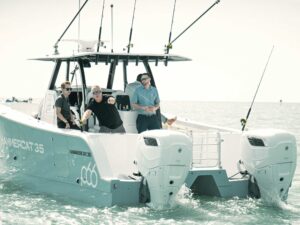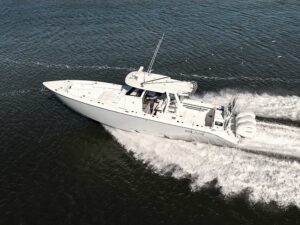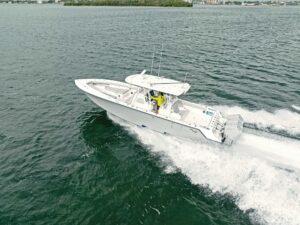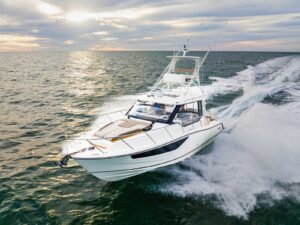Plato wasn’t talking about fishing when he wrote, “necessity, who is the mother of our invention,” although it certainly does apply to our sport. A perfect example is the ability to hold a boat in a precise location in shallow water. The traditional method of slipping an anchor over the side and cleating off the line works, obviously. But that technique is noisy, time-consuming and not exact. It can also damage sensitive sea grasses or bottom habitat. Staking off with an implanted push pole does the job too, unless the bottom is hard-packed sand or rock. Plus, graphite push poles tend to snap when flexed under extreme pressure. That is why skinny-water enthusiasts now have several options to quickly — and quietly — keep boats stationary to cast to wary fish. Floridian John Oliverio, president of JL Marine Systems, which makes Power-Pole, led the movement to develop a better way to stay put in the shallows.
“I was fishing the flats of Sarasota Bay using an anchor, chain and rope, trying to stop before I got too close and spooked the fish,” he recalls. “I thought, ‘If I could just hold right here, I could catch all those snook.’ That’s when I came up with the idea for the Power-Pole. We built the first 10 production models in October 2000, after considerable testing. We made a lot more changes and built another 100. That second batch was almost exactly how all the models are built now.”
The Power-Pole system uses a hinged lightweight metal arm that extends down and away from a boat’s transom. A hydraulic pump drives the integrated fiberglass spike into the bottom to hold the boat in place. The line includes five different models designed for depths from four to 10 feet. The Signature Series Blade Edition is the newest model.
“On the Blade series, we incorporated a bronze and stainless-steel bushing system, a brushless motor and a high-flow pump,” Oliverio says. “The spike tucks into a recessed pocket on the aft arm for better aerodynamics and appearance. But the biggest change is the C-Monster control software. With its Bluetooth chip, the solid state computer is extremely robust and allows the user to tweak the unit to individual preferences.”
Along with precise speed adjustments, wireless control is available with a footpad or remote fob. The Bluetooth compatibility also supports a smartphone app (currently Android, although an iPhone version is in the works) that allows the Power-Pole service department to troubleshoot problems remotely. The 8-foot Blade system retails for $1,845 and comes with a five-year warranty, with a lifetime guarantee on the spike.
Minn Kota’s Talon is another popular shallow-water anchoring system. It’s becoming a common fixture on the transom of bay and flats boats. Instead of a hydraulic pump, the Talon uses a sealed electric motor and gears to deploy a 6-foot-4-inch or 8-foot-4-inch spike to the bottom. Introduced in the summer of 2010, after extensive field testing, the system has several user-friendly features.
“Minn Kota makes a variety of electrical components for the marine industry, and we saw a need for the Talon,” says Sam Heaton, field promotions manager for parent company Johnson Outdoors. Based in Stuart, Florida, Heaton was instrumental in the design and testing of the electromechanical system. “We wanted something that was simple and trouble-free, so the main components are stainless steel and anodized aluminum.”
The Talon is easy to install, either by drilling four mounting holes in the transom or by bolting a bracket behind the engine or on a jack plate. Three wires complete the connection, which is powered by the 12-volt house battery. There is very little current draw when the system is not in use, says Heaton. A wireless remote or control panel on the unit operates the Talon. It also has an LED display to show spike depth and an audible alarm warning if the spike is down when the boat is moved.
A rough-water mode keeps tapping the fiberglass spike into the bottom to compensate for changing wave heights. The 8-foot Talon retails for $1,449 and comes with a one-year warranty. The spike is covered for life. “It’s quick, quiet and a lot less harmful to the environment than a regular anchor,” Heaton says. “It’s so much more stealthier — the fish don’t even know you’re there.”
If you’re looking for ultimate simplicity and lower costs, several companies make manual anchoring spikes designed for skiffs, canoes, kayaks and boats up to the mid-20-foot range. Fabricated from fiberglass, composites, stainless steel or aluminum, these spikes are manually shoved into the bottom and tethered to the boat either with a lanyard or through a mounted bracket. They will stop and hold boats in most conditions (soft mud, sand or grass with moderate current is optimum) with minimal noise. The advantages of lower prices and less maintenance are offset by longer deployment times and more physical effort, however.
With flats-fishing or shallow-water fishing, the mantra is the same as for selling real estate: location, location, location. By adding a shallow-water anchoring system to your boat, you’ll add the ability to precisely stop and cast to fish before they’re aware of your presence, which will mean more hookups. Sometimes stop really is better than go.
Anchor Options
Cajun Marsh Anchors
Stainless-steel and aluminum manual anchoring spikes
www.hhlure.com
Minn Kota Talon
Electromechanical vertical anchoring system
www.minnkotamotors.com
JL Marine Systems Power-Pole
Hydraulic-mechanical extension anchoring system
www.power-pole.com
Skinny Water Products
Aluminum manual anchoring poles and brackets
www.skinnywaterproducts.com
Stick It Anchor Pins
Composite manual spikes and brackets
www.stickitanchorpins.com
Wang Anchor
Fiberglass manual spikes and brackets
www.wanganchor.com









